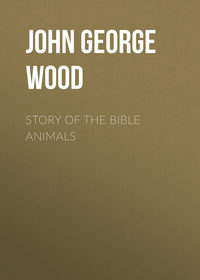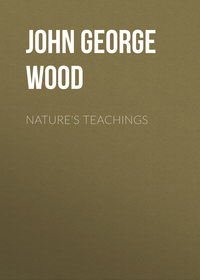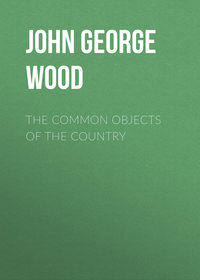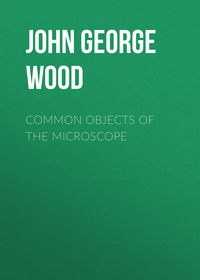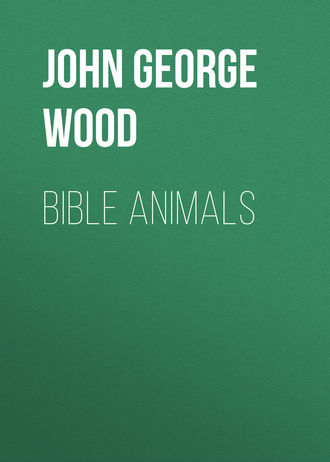 полная версия
полная версияBible Animals
Being one of the lizards, it belongs to the "creeping things," and frequently utters a mournful sound like the word "geck-o." It is exceedingly plentiful, and inhabits the interior of houses, where it can find the flies and other insects on which it lives. On account of the structure of the toes, each of which is flattened into a disk-like form, and furnished on the under surface with a series of plates like those on the back of the sucking-fish, it can walk up a smooth, perpendicular wall with perfect ease, and can even cling to the ceiling like the flies on which it feeds.
The structure of the feet enables it to move about without the least sound, and at first an observer is apt to be rather startled at the mournful cry, and at the silent rapidity with which it darts from place to place.
The Arabs of the present day are horribly afraid of the Gecko, thinking that it poisons everything that it touches, and are even more terrified than are ignorant people in England when they see a toad. Both creatures are equally repulsive in aspect, and equally harmless towards the human race.
THE BADGER
Difficulty in identifying the Tachash of Scripture—References to "Badgers' skins"—The Dugong thought to be the Badger—The Bedouin sandals—Nature of the materials for the Tabernacle—Habits of the Badger—The species found in Palestine—Uses of the Badgers' skins—Looseness of zoological terms.
Until very lately, there was much difficulty in ascertaining whether the word Tachash has been rightly translated as Badger. It occurs in several parts of the Scriptures, and almost invariably is used in relation to a skin or fur of some sort. We will first examine the passages in which the Badger is mentioned, and then proceed to identify the animal.
Nearly all the references to the Badger occur in the book of Exodus, and form part of the directions for constructing the Tabernacle and its contents. The first notice of the word occurs in Exodus xxv. 5, where the people of Israel are ordered to bring their offerings for the sanctuary, among which offerings are gold, silver, and brass, blue, purple, and scarlet, fine linen, goats' hair, rams' skins dyed red, badgers' skins, and shittim wood—all these to be used in the construction of the Tabernacle. Then a little farther on, in chapter xxvi. 14, we find one of the special uses to which the badgers' skins were to be put, namely, to make the outer covering or roof of the tabernacle. Another use for the badgers' skins was to form an outer covering for the ark, table of shewbread, and other furniture of the Tabernacle, when the people were on the march.
In all these cases the badger-skin is used as a covering to defend a building or costly furniture, but there is one example where it is employed for a different purpose. This passage occurs in the book of Ezekiel, chapter xvi. 10. The prophet is speaking of Jerusalem under the image of a woman, and uses these words, "I anointed thee with oil; I clothed thee also with broidered work, and shod thee with badger's skin, and I girded thee about with fine linen, and I covered thee with silk. I decked thee also with ornaments, and I put bracelets upon thy hands, and a chain upon thy neck, and I put a jewel on thy forehead, and earrings in thine ears, and a beautiful crown upon thine head."
So we have here the fact, that the same material which was used for the covering of the Tabernacle, and of the sacred furniture, could also be used for the manufacture of shoes. This passage is the more valuable because of an inference which may be drawn from it. The reader will see that the badger-skin, whatever it may have been, must have been something of considerable value, and therefore, in all probability, something of much rarity.
In the present instance, it is classed with the most luxurious robes that were known in those days, and it is worthy of special mention among the bracelet, earrings, necklace, and coronal with which the symbolized city was adorned. If the reader will now refer to the passage in which the children of Israel were commanded to bring their offerings, he will see that in those cases also the badger-skins were ranked with the costliest articles of apparel that could be found, and had evidently been brought from Egypt, the peculiar home of all the arts; together with the vast quantity of gold and jewels which were used for the same sacred purpose.
Now we find that the badger-skins in question must possess three qualities: they must be costly, they must be capable of forming a defence against the weather, and they must be strong enough to be employed in the manufacture of shoes. If we accept the word Tachash as signifying a Badger, we shall find that these conditions have been fulfilled.
But many commentators have thought that badger-skins could not have been procured in sufficient numbers for the purpose, and have therefore conjectured that some other animal must be signified by the word Tachash.
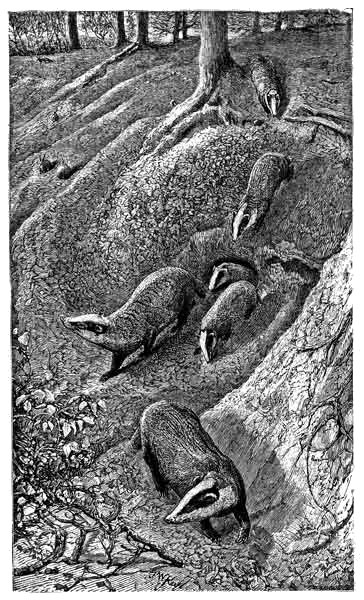
THE BADGER.
"Thou shalt make a covering above of badgers' skins."—Ex. xxvi. 14.
A species of dugong (Halicore hemprichii) is the animal that has been selected as the Badger of the Scriptures. It is one of the marine mammalia, and always lives near the shore, where it can find the various algæ on which it feeds. It is a gregarious animal, and, as it frequently ascends rivers for some distance, it may be captured in sufficient numbers to make both its flesh and skin useful. Moreover, it is of considerable size, fourteen or fifteen feet in length being its usual dimensions, so that a comparatively small number of the skins would be required for the covering of the Tabernacle.
That shoes can be made of it is evident from the fact that at the present day shoes, or rather sandals, are made from its hide, and are commonly used by the Bedouins. But the very qualities and peculiarities which render it a fit material for the sandal of a half-naked Bedouin Arab, who has to walk continually over hard, hot, sandy, and rough ground, would surely make it unsuitable for the delicate shoes worn by a woman of rank who spends her time in the house, and the rest of whose clothing is of fine linen and silk, embroidered with gold and jewels. In our own country, the hobnailed shoes of the ploughman and the slight shoe of a lady are made of very different materials, and it is reasonable to conjecture that such was the case when the passage in question was written.
Then Dr. Robinson, who admits that the hide of the dugong could hardly have been used as the material for a lady's shoe, thinks that it would have answered very well for the roof of the Tabernacle, because it was large, clumsy, and coarse. It seems strange that he did not also perceive that the two latter qualities would completely disqualify such skins for that service. Everything clumsy and coarse was studiously prohibited, and nothing but the very best was considered fit for the Tabernacle of the Lord. By special revelation, Moses was instructed to procure, not merely the ordinary timber of the country for the framework—not only the fabrics which would keep out rain and wind—not simply the metals in common use, from which to make the lamps and other furniture—not the ordinary oils for supplying the lamps; but, on the contrary, the finest linen, the most elaborate embroidery, the rarest woods, the purest gold, the costliest gems, were demanded, and nothing common or inferior was accepted. The commonest material that was permitted was the long, soft fleece of rams' wool; but, even in that case, the wool had to be dyed of the regal scarlet—a dye so rare and so costly that none but the wealthiest rulers could use it. Even the very oil that burned in the lamps must be the purest olive-oil, prepared expressly for that purpose.
The very fact, therefore, that any article was plentiful and could easily be obtained, would be a proof that such article was not used for so sacred a purpose; while it is impossible that anything coarse and clumsy could have been accepted for the construction of that Tabernacle within which the Shekinah ever burned over the Mercy-seat—over which the cloud rested by day, and the fire shone by night, visible external proofs of the Divine glory within.
We therefore dismiss from our minds the possibility of accepting any material for it which was not exceptionably valuable, and which would be employed in the uses of ordinary life. The great object of the minutely-elaborate directions which were given through Moses to the Israelites was evidently to keep continually before their eyes the great truth that they owed all to God, and that their costliest offerings were but acknowledgments of their dependence.
We will now presume that the Tachash of the Pentateuch and Ezekiel is really the animal which we know by the name of Badger. It exists throughout the whole of the district traversed by the Israelites, though it is not very plentiful, nor is it easily taken. Had such been the case, its fur would not have been employed in the service of the sanctuary.
It is nocturnal in its habits, and very seldom is seen during the hours of daylight, so that it cannot be captured by chase. It is not gregarious, so that it cannot be taken in great numbers, as is the case with certain wild animals which have been thought to be the Tachash of Scripture. It is not a careless animal, so that it cannot be captured or killed without the exercise of considerable ingenuity, and the expenditure of much time and trouble. It is one of the burrowing animals, digging for itself a deep subterranean home, and always ready whenever it is alarmed to escape into the dark recesses of its dwelling, from which it can scarcely be dislodged. It is not a large animal, so that a considerable number of skins would be required in order to make a covering which should overlap a structure forty-five feet in length and fifteen in breadth. Were it a solitary animal, there might be a difficulty in procuring a sufficient number of skins. But it is partly gregarious in its habits, living together in small families, seven or eight being sometimes found to inhabit a single dwelling-place. It is, therefore, sufficiently rare to make its skin valuable, and sufficiently plentiful to furnish the requisite number of skins. All these facts tend to show that the cost of such a covering must have been very great, even though it was the outermost, and, consequently, the least valuable of the four. It has been suggested that these skins were only used to lay over the lines where the different sets of coverings overlapped each other, and that, in consequence, they need not have been very numerous.
But we find that these same skins, which were evidently those which formed the external roof, were used, when the Tabernacle was taken down, for the purpose of forming distinct coverings for the ark of the testimony, the table of shewbread, the seven-branched candlestick, the golden altar, the various vessels used in the ministrations, and lastly, the altar of sacrifice itself. Thus, when we recollect the dimensions of the ark, the table, the candlestick, and the two altars, we shall see that, in order to make separate covers for them, a quantity of material would be used which would be amply sufficient to cover the whole roof of the Tabernacle, even if it had, as was most probably the case, a ridged, and not a flat roof.
We now come to our next point, namely, the aptitude of the Badger's skin to resist weather. Any one who has handled the skin of the Badger will acknowledge that a better material could hardly be found. The fur is long, thick, and, though light, is moderately stiff, the hairs falling over each other in such a manner as to throw off rain or snow as off a penthouse. And, as to the third point, namely, its possible use as a material for the manufacture of shoes, we may call to mind that the skin of the Badger is proverbially tough, and that this very quality has caused the animal to be subjected to most cruel treatment by a class of sporting men which is now almost extinct.
The Septuagint gives little assistance in determining the precise nature of the Tachash, and rather seems to consider the word as expressive of the colour with which the fur was dyed than that of the animal from which it was taken. Still, it must be remembered that not only are zoological terms used very loosely in the Scriptures, but that in Hebrew, as in all other languages, the same combination of letters often expresses two different ideas, so that the word Tachash may equally signify a colour and an animal. Moreover, it has been well pointed out that the repeated use of the word in the plural number shows that it cannot refer to colour; while its almost invariable combination with the Hebrew word that signifies a skin implies that it does not refer to colour, but to an animal.
What that animal may be, is, as I have already mentioned, conjectural. But, as the authorized translation renders the word as Badger, and as this reading fulfils the conditions necessary to its identification, and as no other reading does fulfil them, we cannot be very far wrong if we accept that translation as the correct one, and assume the Tachash of the Scriptures to be the animal which we call by the name of Badger.
THE BEAR
The Syrian Bear—Identity of the Hebrew and Arabic titles—Its colour variable according to age—Bears once numerous in Palestine, and now only occasionally seen—Reason for their diminution—Present localities of the Bear, and its favourite haunts—Food of the Bear—Its general habits—Its ravages among the flocks—The Bear dangerous to mankind—The Bear robbed of her whelps—Illustrative passages—Its mode of fighting—Various references to the Bear, from the time of Samuel to that of St. John.
Whatever doubt may exist as to the precise identity of various animals mentioned in the Scriptures, there is none whatever as to the creature which is frequently alluded to under the name of Bear.

"As a roaring lion and a ranging bear, so is a wicked ruler over the poor people."—Prov. xxviii. 15.
The Hebrew word is Dôb, and it is a remarkable fact that the name of this animal in the Arabic language is almost identical with the Hebrew term, namely, Dubh. The peculiar species of Bear which inhabits Palestine is the Syrian Bear (Ursus Isabellinu s), and, though it has been variously described by different eye-witnesses, there is no doubt that the same species was seen by them all. As is the case with many animals, the Syrian Bear changes its colour as it grows older. When a cub, it is of a darkish brown, which becomes a light brown as it approaches maturity. But, when it has attained its full growth, it becomes cream-coloured, and each succeeding year seems to lighten its coat, so that a very old Bear is nearly as white as its relative of the Arctic regions. Travellers, therefore, who have met the younger specimens, have described them as brown in hue, while those who have seen more aged individuals have stated that the colour of the Syrian Bear is white.
Owing to the destruction of forests, the Bear, which is essentially a lover of the woods, has decreased considerably in number. Yet, even at the present time, specimens may be seen by the watchful traveller, mostly about the range of Lebanon, but sometimes at a considerable distance from that locality. Mr. Tristram, for example, saw it close to the Lake of Gennesaret. "We never met with so many wild animals as on one of those days. First of all, a wild boar got out of some scrub close to us, as we were ascending the valley. Then a deer was started below, ran up the cliff, and wound along the ledge, passing close to us. Then a large ichneumon almost crossed my feet and ran into a cleft; and, while endeavouring to trace him, I was amazed to see a brown Syrian Bear clumsily but rapidly clamber down the rocks and cross the ravine. He was, however, far too cautious to get within hailing distance of any of the riflemen."
The same author mentions that some of the chief strongholds of this Bear are certain clefts in the face of a precipitous chasm through which the river Leontes flows. This river runs into the sea a few miles northward of Tyre, and assists in carrying off the melted snows from the Lebanon range of mountains. His description is so picturesque, that it must be given in his own words. "The channel, though a thousand feet deep, was so narrow that the opposite ridge was within gunshot. Looking down the giddy abyss, we could see the cliff on our side partially covered with myrtle, bay, and caper hanging from the fissures, while the opposite side was perforated with many shallow caves, the inaccessible eyries of vultures, eagles, and lanner falcons, which were sailing in multitudes around. The lower part had many ledges clad with shrubs, the strongholds of the Syrian Bear, though inaccessible even to goats. Far beneath dashed the milk-white river, a silver line in a ruby setting of oleanders, roaring doubtless fiercely, but too distant to be heard at the height on which we stood. This cleft of the Leontes was the only true Alpine scenery we had met with in Palestine, and in any country, and amidst any mountains, it would attract admiration."
On those elevated spots the Bear loves to dwell, and throughout the summer-time generally remains in such localities. For the Bear is one of the omnivorous animals, and is able to feed on vegetable as well as animal substances, preferring the former when they can be found. There is nothing that a Bear likes better than strawberries and similar fruits, among which it will revel throughout the whole fruit season, daintily picking the ripest berries, and becoming wonderfully fat by the constant banquet. Sometimes, when the fruits fail, it makes incursions among the cultivated grounds, and is noted for the ravages which it makes among a sort of vetch which is much grown in the Holy Land.
But during the colder months of the year the Bear changes its diet, and becomes carnivorous. Sometimes it contents itself with the various wild animals which it can secure, but sometimes it descends to the lower plains, and seizes upon the goats and sheep in their pastures. This habit is referred to by David, in his well-known speech to Saul, when the king was trying to dissuade him from matching himself against the gigantic Philistine. "And Saul said to David, Thou art not able to go against this Philistine to fight with him: for thou art but a youth, and he a man of war from his youth.... Thy servant kept his father's sheep, and there came a lion and a bear, and took a lamb out of the flock: and I went out after him, and smote him, and delivered it out of his hand; and when he arose against me, I caught him by the beard, and smote him, and slew him. Thy servant slew both the lion and the bear: and this uncircumcised Philistine shall be as one of them, seeing he hath defied the armies of the living God."—1 Sam. xvii. 33-36.
Though not generally apt to attack mankind, it will do so if first attacked, and then becomes a most dangerous enemy. See, for example, that most graphic passage in the book of the prophet Amos, whose business as a herdsman must have made him conversant with the habits, not only of the flocks and herds which he kept, but of the wild beasts which might devour them:—"Woe unto you that desire the day of the Lord! to what end is it for you? the day of the Lord is darkness, and not light. As if a man did flee from a lion, and a bear met him; or went into a house, and leaned his hand on the wall, and a serpent bit him." (v. 19.)
Another reference to the dangerous character of the Bear is made in 2 Kings ii. 23, 24, in which is recorded that two she-bears came out of the wood near Bethel, and killed forty-two of the children that mocked at Elisha.
As the Bear is not swift of foot, but rather clumsy in its movements, it cannot hope to take the nimbler animals in open chase. It prefers to lie in wait for them in the bushes, and to strike them down with a sudden blow of its paw, a terrible weapon, which it can wield as effectively as the lion uses its claws. An allusion to this habit is made in the Lamentations of Jeremiah (iii. 10), "He was unto me as a bear lying in wait, and as a lion in secret places."
Harmless to man as it generally is, there are occasions on which it becomes a terrible and relentless foe, not seeking to avoid his presence, but even searching for him, and attacking him as soon as seen. In the proper season of the year, hunters, or those who are travelling through those parts of the country infested by the Bear, will sometimes find the cubs, generally two in number, their mother having left them in the den while she has gone to search for food. Although they would not venture to take the initiative in an attack upon either of the parents, they are glad of an opportunity which enables them to destroy one or two Bears without danger to themselves. The young Bears are easily killed or carried off, because at a very early age they are as confident as they are weak, and do not try to escape when they see the hunters approaching.
The only danger lies in the possibility that their deed may be discovered by the mother before they can escape from the locality, and, if she should happen to return while the robbers are still in the neighbourhood, a severe conflict is sure to follow. At any time an angry Bear is a terrible antagonist, especially if it be wounded with sufficient severity to cause pain, and not severely enough to cripple its movements. But, when to this easily-roused ferocity is added the fury of maternal feelings, it may be imagined that the hunters have good reason to fear its attack.
To all animals that rear their young is given a sublime and almost supernatural courage in defending their offspring, and from the lioness, that charges a host of armed men when her cubs are in danger, to the hen, which defies the soaring kite or prowling fox, or to the spider, that will give up her life rather than abandon her yet unhatched brood, the same self-sacrificing spirit actuates them all. Most terrible therefore is the wrath of a creature which possesses, as is the case of the Bear, the strongest maternal affections, added to great size, tremendous weapons, and gigantic strength. That the sight of a Bear bereaved of her young was well known to both writers and contemporary readers of the Old Testament, is evident from the fact that it is mentioned by several writers, and always as a familiar illustration of furious anger. See for example 2 Sam. xvii. 8, when Hushai is dissuading Absalom from following the cautious counsel of Ahithophel, "For thou knowest thy father and his men, that they be mighty men of war, and they be chafed in their minds as a bear robbed of her whelps in the field." Solomon also, in the Proverbs (xvii. 12), uses the same image, "Let a bear robbed of her whelps meet a man, rather than a fool in his folly."
When the Bear fights, it delivers rapid strokes with its armed paw, tearing and rending away everything that it strikes. A blow from a bear's paw has been several times known to strip the entire skin, together with the hair, from a man's head, and, when fighting with dogs, to tear its enemies open as if each claw were a chisel. This mode of fighting is clearly alluded to by the prophet Hosea, who seems, from the graphic force of his sentences, to have been an actual spectator of some such combat, "I will meet them as a bear that is bereaved of her whelps, and will rend the caul of their heart" (Hos. xiii. 8).
That the Bear was a well-known animal both in the earlier and later times of the Scripture is also evident from the fact that it was twice used as a symbol exhibited to a seer in a vision. The first of these passages occurs in the book of Daniel (vii. 5), when the prophet is describing the wonderful vision of the four beasts:—"And behold another beast, a second, like to a bear, and it raised up itself on one side, and it had three ribs in the mouth of it, between the teeth of it, and they said thus unto it, Arise, devour much flesh." The second allusion occurs in the Revelation, the seven-headed and ten-crowned beast having a form like that of a leopard, but feet like those of a Bear.
THE HEDGEHOG, OR BITTERN
Various readings of the word Kippôd—The Jewish Bible and its object—The Syrian Hedgehog and its appearance—Its fondness for dry spots—The prophecies of Isaiah and Zephaniah, and their bearing on the subject—The Porcupine supposed to be the Kippôd—The Hedgehog and Porcupine called by the same name in Greek and Arabic—Habits of the Porcupine—Its quills, and the manner of their shedding.




